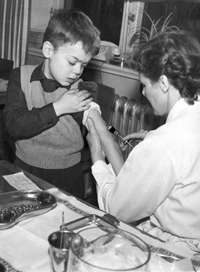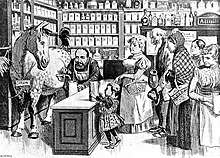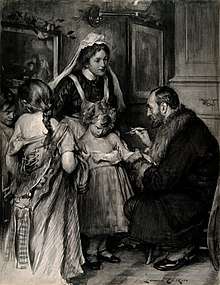
It is courage based on confidence, not daring, and it is confidence based on experience. ~ Jonas Salk

Vaccination as a deliberate attempt to protect humans against disease has a short history when measured against the thousands of years that humans have sought to rid themselves of plagues and pestilence. Only in the 20th century did the practice flower into the routine vaccination of large populations. Yet, despite its relative youth, the impact of vaccination on the health of the world's peoples is hard to exaggerate. ~ Plotkin's Vaccines

Modern air travel has made prophylactic vaccination more important than ever, because this mode of transportation has greatly facilitated the spread of contagious pathogens. ~ Primer to the Immune Response

Vaccinations are a cornerstone of pediatric care. Traveling children need special attention to their vaccine status. Updating all routine vaccinations and accelerating those in the primary series should be done if possible. ~ Travel Medicine

The human body can take care of itself in many circumstances—cuts, colds, and minor infections disappear without major upheaval. In other cases, the body has little or no naturally occurring immunity, so if you are exposed to diseases such as polio, influenza, smallpox, hepatitis, diphtheria, measles, or whooping cough, you will probably get sick with it, unless you have been immunized. ~ Smithsonian Institute
Vaccines are biological preparations that provides active acquired immunity to a particular disease. A vaccine typically contains an agent that resembles a disease-causing microorganism and is often made from weakened or killed forms of the microbe, its toxins, or one of its surface proteins. The agent stimulates the body's immune system to recognize the agent as a threat, destroy it, and to further recognize and destroy any of the microorganisms associated with that agent that it may encounter in the future.
Quotes
- Most of the objections...are based unconsciously on a feeling that there should be higher methods of controlling diseases in man, than by injecting into the human body substance taken from the bodies of animals. That is most surely and definitely correct, and some day it will be demonstrated. Another reaction on their part is one of sensitive disgust, again largely unrecognised. A more vital objection should be based on the suffering entailed on the animals providing the vaccine and other substances.
- Alice Bailey in Esoteric Healing (A Treatise on the Seven Rays), p.322/4, (1953).
- The science of inoculation is purely physical in origin, and concerns only the animal body. This latter science will shortly be superseded by a higher technique, but the time is not yet.
- Alice Bailey in Esoteric Healing (A Treatise on the Seven Rays) p.322/4 (1953).
- Edward R. Murrow: Who owns the patent on this vaccine?
Jonas Salk: Well, the people, I would say. There is no patent. Could you patent the sun?- CBS Television interview, on See It Now (12 April 1955); quoted in Shots in the Dark : The Wayward Search for an AIDS Vaccine (2001) by Jon Cohen.
- While vaccines (excepting those homoeopathically produced) may not be the best and final solution to conquering diseases, on a mass scale they have brought much benefit and freedom from crippling diseases in Africa, India and many other countries.
- Benjamin Creme in Share International magazine , (May 2002).
- Several accounts from the 1500s describe smallpox inoculation as practices in China and India (one is referred to in volume 6 of Joseph Needham’s Science and civilization in China). Glynn and Glynn, in the The Life and Death of Smallpox, note that in the late 1600s Emperor K’ang His, who had survived smallpox as a child, had his children inoculated. That method involved grinding up smallpox scabs and blowing the matter into nostril, inoculation may also have been practiced by scratching matter from a smallpox sore into the skin. It is difficult to point when the practice began, as some sources claim dates as early as 300 BCE.
- Chinese Smallpox Inoculation, History of vaccines.org, College of Physicians of Philadelphia.
- I am not surprised that men are not thankful to me; but I wonder that they are not grateful to God for the good which he has made me the instrument of conveying to my fellow-creatures.
- It’s quite stunning to watch liberals applauding censorship, particularly the muzzling of the bullied mothers of injured children in order to protect pharmaceutical products from criticism.
- Robert F. Kennedy Jr., Twitter, (March 3, 2019)
- Vaccinations are a cornerstone of pediatric care. Traveling children need special attention to their vaccine status. Updating all routine vaccinations and accelerating those in the primary series should be done if possible. The immune system of infants and children responds differently to different types of vaccines. Safety and efficacy considerations guide vaccine recommendations for all pediatric vaccinations. Age limitations on vaccinations may be due to safety concerns (e.g., yellow fever vaccine), immune system response capability (polysaccharide vaccines), maternal antibody interference (e.g., measles, hepatitis A), or lack of data. Travel-specific recommendations may differ for vaccinating children compared with adults based on these details.
- Sheila M. Mackell, Mike Starr, “Pediatric Travel Vaccinations”, in Travel Medicine (Fourth Edition), (2019)
- Vaccination is a clinical application of immunization designed to artificially help the body to defend itself. A vaccine against infection is a modified form of a natural immunogen, which may be either the whole pathogen, one of its components, or a toxin. A vaccine does not cause disease when administered but induces the healthy host (the vaccinee) to mount a primary response against epitopes of the modified immunogen and to generate large numbers of memory B and T cells. In an unvaccinated individual (Fig. 14-1, left panel), naïve B and T cells capable of combatting an infecting pathogen are present in relatively low numbers when the pathogen is first encountered. A primary immune response is all that can be mounted so that, in many cases, the individual becomes sick until antibodies and/or effector T cells can act to clear the attacker. In a vaccinated individual (Fig. 14-1, right panel), a collection of circulating antibodies and an expanded army of pathogen-specific memory B and T cells have already been generated prior to a first exposure to the natural pathogen. When the natural pathogen attacks, the circulating antibodies provide a degree of immediate protection from the invader. In addition, the memory B and T cells are quickly activated, and a secondary response is mounted that rapidly clears the infection before it can cause serious illness. This type of vaccination is called prophylactic vaccination because it is intended to prevent disease.
- Tak W. Mak, Mary E. Saunders, Bradley D. Jett; “Primer to the Immune Response (Second Edition)”, (2014)
- NOTE: Modern air travel has made prophylactic vaccination more important than ever, because this mode of transportation has greatly facilitated the spread of contagious pathogens. For example, in 2010, an unvaccinated child who contracted measles in Europe transmitted the virus to a fellow passenger during a flight to the U.S. This passenger then attended a conference and unwittingly exposed 270 other individuals to the disease.
Vaccination can be thought of as a form of active immunization, because the individual is administered a pathogen antigen and his/her body is responsible for activating the lymphocytes and making the antibodies necessary to provide defense against future assaults. In contrast, passive immunization is the term used to describe the transfer of protective anti-bodies from an immune individual to an unimmunized individual.- Tak W. Mak, Mary E. Saunders, Bradley D. Jett; “Primer to the Immune Response (Second Edition)”, (2014)
- Today’s best known vaccination success story is the global campaign of the World Health Organization (WHO) to eradicate smallpox. In 1967, the WHO began its coordination of 200,000 health workers who took 10 years to vaccinate the world’s population in its remotest corners. Between 1976 and 1979, only one case of smallpox was recorded, leading to the declaration in 1980 that smallpox had been officially eradicated (Plate 14-1). A similar global immunization program against rinderpest is currently pushing this pathogen toward extinction (Box 14-2).
- Tak W. Mak, Mary E. Saunders, Bradley D. Jett; “Primer to the Immune Response (Second Edition)”, (2014)
- Vaccination as a deliberate attempt to protect humans against disease has a short history when measured against the thousands of years that humans have sought to rid themselves of plagues and pestilence. Only in the 20th century did the practice flower into the routine vaccination of large populations. Yet, despite its relative youth, the impact of vaccination on the health of the world's peoples is hard to exaggerate. With the exception of safe water, no other intervention, not even antibiotics, has had such a major effect on mortality reduction and population growth.
Since the first vaccine was introduced by Edward Jenner (Fig. 1.1) in 1798, vaccination has controlled 14 major diseases, at least in parts of the world: smallpox, diphtheria, tetanus, yellow fever, pertussis, [[w:Haemophilus influenzae type b disease|, poliomyelitis, measles, mumps], rubella, typhoid, rabies, rotavirus, and hepatitis B. For smallpox, the dream of eradication has been fulfilled; naturally occurring smallpox has disappeared from the world. Cases of poliomyelitis have been reduced by 99% and this disease also is targeted for eradication. Rubella and congenital rubella syn-drome have been officially declared eliminated from the Americas as of 2015. Vaccinations against many other diseases have made major headway. The path to these successes is worth examining.- Susan L. Plotkin, Stanley A. Plotkin, in Plotkin's Vaccines (Seventh Edition), ch.1, A Short History of Vaccination, (2018)
- In the 7th century, some Indian Buddhists drank snake venom in an attempt to become immune to its effect. They may have been inducing antitoxin-like immunity. In the 16th century, Brahmin Hindus in India practiced a form of variolation by introducing dried pus from smallpox pustules into the skin of a patient. Writings that cite the use of inoculation and variolation in 10th-century China–make interesting reading but apparently cannot be verified. There is, however, 18th-century documentation of Chinese variolation. The Golden Mirror of Medicine, a medical text dated 1742, listed four forms of inoculation against Smallpox practiced in China since 1695: The nose plugged with powdered scabs laid on cotton wool. Powdered scabs blown into the nose. The undergarments of an infected child put on a healthy child for several days. A piece of cotton smeared with the contents of a vesicle and stuffed into the nose. This text, endorsed by the Imperial Court, raised the status of variolation in China, which previously had been considered just a folk remedy. Another Chinese text, published a century before Jenner’s work, stated that white cow fleas were used for smallpox prevention. The fleas were ground into powder and made into pills.
- Susan L. Plotkin, Stanley A. Plotkin, in Plotkin's Vaccines (Seventh Edition), ch.1, A Short History of Vaccination, (2018)
- Vaccination against destination-specific diseases plays an important role in preparing a traveler, although vaccine preventable diseases (VPDs) are rare in returning persons. While mandatory vaccinations in international travel are restricted to yellow fever, meningococcal meningitis (hajj), and rarely other vaccinations in special outbreak situations, recommendation for individual precaution by vaccination is based on data from returning travelers and from the epidemiologic situation in the visiting country. Weighing risk of vaccination against the benefit for the traveler is a prerequisite for pro/con decisions and implies de-tailed evaluation of personal risk of contracting a VPD. However, the currently licensed vaccines indi-cated for an international traveler are considered safe, well tolerated, and efficacious.
- Joseph Torresi, Herwig Kollaritsch, “Recommended/Required Travel Vaccines”, in Travel Medicine (Fourth Edition), (2019)
- It is courage based on confidence, not daring, and it is confidence based on experience.
- Jonas Salk, on testing his vaccine against polio on himself, his wife, and his three sons, (9 May 1955).
- 'Flying vaccinator' is the concept of using genetically engineered hematophagous insects to deliver vaccines. Here we show the generation of a transgenic anopheline mosquito that expresses the Leishmania vaccine candidate, SP15, fused to monomeric red fluorescent protein (mDsRed) in its salivary glands. Importantly, mice bitten repeatedly by the transgenic mosquitoes raised anti‐SP15 antibodies, indicating delivery of SP15 via blood feeding with its immunogenicity intact. Thus, this technology makes possible the generation of transgenic mosquitoes that match the original concept of a ‘flying vaccinator’. However, medical safety issues and concerns about informed consent mitigate the use of the ‘flying vaccinator’ as a method to deliver vaccines.
- D. S. Yamamoto, H. Nagumo, S. Yoshida, “Flying vaccinator; a transgenic mosquito delivers a Leishmania vaccine via blood feeding”, Insect Molecular Biology, (04 May 2010).
Donald G. McNeil Jr., “Religious Objections to the Measles Vaccine? Get the Shots, Faith Leaders Say”, The New York Times, (April 26, 2019)
- Vaccines, the activists say, contain ingredients made from pigs, dogs, monkeys and aborted fetuses. Indeed, most of those assertions are based in fact. Ingredient lists published by the Centers for Disease Control and Prevention and the Institute for Vaccine Safety at Johns Hopkins show that vaccines may contain these elements (although any residual DNA is present only at the parts-per-million level).
Nonetheless, vaccination is endorsed by top Jewish and Islamic scholars, and by the Vatican. Religious authorities have meticulously studied how vaccines are made and what is in them, and still have ruled that they do not violate Jewish, Islamic or Catholic law.
Although no vaccine is without side effects, immunization is one of the greatest advances in medicine. The World Health Organization estimates that vaccines have saved more than 10 million lives in just the last decade. - Vaccines are highly purified, but they still may contain isolated cells or traces of DNA from the human or animal cells they were grown in. Those “growth media” include cell lines originally derived — often decades ago — from monkey or dog kidneys, moth caterpillars, |calf blood, or the immature tissues of aborted human fetuses. (The widely circulated assertion that vaccines contain rat DNA is untrue.)
Some vaccines grown in eggs or using dairy products contain residual egg or casein proteins. And in some vaccines, the manufacturers add small doses of gelatin made from pig skin to prevent damage from heat or freeze-drying.
As New York’s current measles outbreak has spread, the more obscure ingredients of the measles vaccine — which is often delivered in a shot mixed with vaccines against mumps, rubella and chickenpox — have become an issue for some Orthodox Jews. - [K]osher dietary laws are “just a total nonissue” with regard to vaccines, said Dr. Naor Bar-Zeev, a professor of international health and vaccine science at the Johns Hopkins Bloomberg School of Public Health. “All these complex laws apply to food ingested by mouth and are not in any way relevant to injected material.”
- Vaccines against viral diseases are made from viruses, which are just protein shells containing short stretches of DNA or RNA and can multiply only when grown in broths of live cells. Those cells are unusual in that they must be “immortal” — that is, able to replicate for decades without suffering “cell death,” the aging process.
(The best-known example is HeLa cells, which were isolated from a tumor in a woman named Henrietta Lacks, who died in 1951. More than 50 million tons of HeLa cells have since been grown for use in cancer research.)
The cells also must be free of cancer and viruses, which is one reason the ancestor cells come from fetuses that have never been exposed to pathogens — fetuses that were removed in sterile surgical environments, not from miscarriages. - Catholics, the Vatican said, must choose alternative vaccines if they exist and press vaccine companies to make alternatives.
Nonetheless, because there are no alternatives, the use of existing vaccines — particularly against rubella, the Vatican ruled — was “morally justified” because of the higher need to protect children and pregnant women.
The Vatican reiterated that position as recently as two years ago in guidelines for Catholic health workers.
Mormons, Episcopalians, Lutherans and many other Christian denominations endorse vaccines, require them in their schools and distribute them at their missionary hospitals.
High authorities of all other major religions back vaccination, according to a study by Dorit R. Reiss, a medical law expert at the University of California Hastings Law School, and a paper in the journal Vaccine by John D. Grabenstein, an employee of Merck’s vaccine division.
Among Buddhists, the Dalai Lama has personally given polio vaccine to children to further the world polio-eradication drive. One of the first accounts of variolation — an ancient form of smallpox prevention — was from an 11th century Buddhist nun, who blew ground smallpox scabs into the noses of her patients.
External links
This article is issued from
Wikiquote.
The text is licensed under Creative
Commons - Attribution - Sharealike.
Additional terms may apply for the media files.
